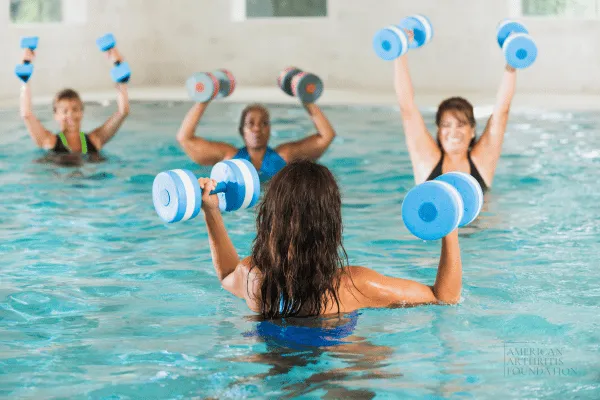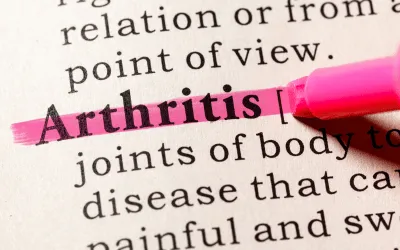About Arthritis
As the nation’s #1 cause of disability, arthritis affects nearly 60 million adults and 300,000 children. Over 100 types of arthritis and related conditions damage the joints and often other organs.
How can we assist you?
Helpful Tools for You

How Water-Based Exercise Is Transforming Arthritis Care
Imagine being able to exercise for an hour without joint pain flaring up. Picture walking, jogging, and stretching with the confidence that you won't hurt yourself or trigger stiffness the next day. For millions of people living with arthritis, this might sound like an impossible dream—but it's becoming an everyday reality through aquatic therapy.
Whether you call it water therapy, hydrotherapy, or aquatic exercise, this gentle approach is revolutionizing how people with joint pain stay active. Recent research from 2024-2025 shows that aquatic therapy isn't just effective—it's often superior to traditional land-based exercise for managing arthritis symptoms.
Why Traditional Exercise Feels Like a Battle (And How Water Changes Everything)
If you have arthritis, you've probably experienced this frustrating cycle: Your doctor tells you that exercise is crucial for managing your condition, but every time you try to work out, your joints protest. Walking on hard surfaces sends shooting pain through your knees. Lifting weights aggravates your wrists. Even gentle stretching can leave you stiff and sore.
This is where water becomes your ally instead of your enemy.
When you exercise in water, something magical happens: gravity loosens its grip on your body. The buoyancy of water supports up to 90% of your body weight when you're neck-deep, instantly reducing the pressure on your joints. It's like having a built-in support system that moves with you.
The Science Behind the Splash: What 2025 Research Tells Us
The latest studies are painting an increasingly clear picture of aquatic therapy's benefits for arthritis:
Pain Relief That Outperforms Land Exercise
A comprehensive 2025 systematic review analyzing data from over 756 participants found that aquatic exercise produced a 0.61-point reduction in pain compared to no exercise, and was more effective at reducing pain than land-based exercise. The researchers noted that warm pool water particularly excels at relaxing muscles and nerve endings.
Significant Improvement in Daily Function
The same research showed that aquatic exercise led to a 0.77-point improvement in quality of life and 0.34-point reduction in joint dysfunction. These numbers translate to real-world improvements: climbing stairs more easily, walking longer distances, and performing daily tasks with greater confidence.
Long-lasting Benefits
Studies spanning up to three months found that quality of life continued improving the longer people participated in aquatic programs. This suggests that water exercise doesn't just provide temporary relief—it creates lasting positive changes.
Superior Safety Profile
Unlike high-impact land activities associated with higher injury rates, aquatic exercise maintains an extremely low risk of injury, making it ideal for older adults and those with multiple health conditions.
Beyond Arthritis: The Whole-Body Benefits
While pain relief might bring you to the pool, the additional benefits will keep you there:
Cognitive Enhancement
A groundbreaking 2024 study found that older adults who participated in aquatic exercise programs for 28 weeks experienced greater improvements in cognitive function compared to those who didn't exercise in water. The researchers believe the combination of physical movement and the meditative qualities of water contribute to brain health.
Muscle Strengthening Without Strain
Water provides 12 times more resistance than air, meaning every movement becomes a strength-training exercise. You're essentially lifting weights using your own body weight, but without the jarring impact on joints.
Balance and Fall Prevention
The supportive environment of water allows you to practice balance exercises safely. Recent studies show significant improvements in balance and gait patterns among older adults participating in aqua aerobics, leading to increased confidence in daily activities.
Mental Health Boost
Beyond the physical benefits, many participants report that aquatic exercise helps combat the depression and anxiety that often accompany chronic pain conditions. The social aspect of group classes and the meditative quality of moving through water contribute to improved mental well-being.
Types of Aquatic Therapy: Finding Your Perfect Fit
Warm Water Therapy Pools (90-94°F)
These specialized pools are designed specifically for therapeutic exercise. The warm temperature helps relax muscles and improve circulation, making movement easier and more comfortable. Many feature:
Underwater treadmills for safe walking practice
Resistance jets for strength training
Handrails and entry ramps for accessibility
Depths ranging from 3-6 feet to accommodate different abilities
Water Aerobics Classes
Perfect for those who enjoy group exercise and social interaction. These classes typically include:
Warm-up movements in shallow water
Cardiovascular exercises using water resistance
Strength-building activities with water weights or noodles
Cool-down stretches and relaxation
Individual Aquatic Therapy with a Physical Therapist
For people with specific limitations or rehabilitation needs:
One-on-one guidance from trained professionals
Customized exercise programs
Progress monitoring and exercise modification
Integration with overall treatment plans
Independent Water Exercise
For confident swimmers or those comfortable in water:
Lap swimming at your own pace
Water walking in shallow or deep water
Using flotation devices for supported exercise
Following online aquatic exercise programs
Getting Started: Your First Steps Into Aquatic Therapy
Before You Begin: Essential Considerations
Consult Your Doctor First: While aquatic therapy is generally safe, some conditions require special precautions. People with uncontrolled high blood pressure, congestive heart failure, or severe breathing disorders should get clearance before exercising in water deeper than waist-level.
Choose the Right Program: Consider your comfort level in water, swimming ability, and specific health goals when selecting a program.
What to Expect in Your First Session
Water Temperature: Most therapeutic pools maintain temperatures between 83-88°F (28-31°C), warm enough to relax muscles but cool enough to allow for exercise without overheating.
Duration: Sessions typically last 45-60 minutes, but beginners often start with 30-minute sessions and gradually increase duration.
Intensity: Programs can be adapted for all fitness levels, from gentle range-of-motion exercises to high-intensity interval training.
Essential Equipment for Success
What You'll Need:
Comfortable swimsuit that allows for movement
Water shoes for better traction
Water bottle for hydration (yes, you still sweat in water!)
Towel and change of clothes
Helpful Accessories:
Flotation belt or vest for deep water exercises
Water weights or resistance equipment
Pool noodles for support and resistance
Waterproof fitness tracker to monitor progress
Sample Beginner Routine: Your First Week in the Water
Here's a gentle 30-minute routine perfect for beginners with arthritis:
Warm-Up (5 minutes)
Walk forward, backward, and sideways in chest-deep water
Gentle arm circles and shoulder rolls
Marching in place with high knees
Cardiovascular Activity (10 minutes)
Water jogging with flotation belt
Cross-country skiing motion
Jumping jacks (modified for comfort)
Strength Training (10 minutes)
Leg swings (front to back, side to side)
Arm pushes and pulls using water resistance
Gentle squats holding pool edge
Calf raises
Cool-Down (5 minutes)
Slow walking
Gentle stretching of arms, legs, and neck
Deep breathing exercises while floating or standing
Finding Aquatic Programs in Your Community
Where to Look:
Community Centers and YMCAs: Often offer affordable water aerobics classes
Physical Therapy Clinics: Provide medically supervised aquatic therapy
Health Systems and Hospitals: May have warm-water therapy pools
Senior Centers: Frequently host arthritis-specific aquatic programs
Private Fitness Centers: Some offer specialized aquatic therapy services
Questions to Ask When Choosing a Program:
What is the water temperature?
Are instructors trained in working with people who have arthritis?
What safety measures are in place?
Can the program be modified for different ability levels?
Are there changing rooms and accessibility features?
Making Aquatic Therapy Part of Your Long-Term Health Strategy
Setting Realistic Goals
Week 1-2: Focus on comfort and familiarity with water exercise Month 1: Build endurance and establish routine Month 2-3: Increase intensity and add new movements Beyond 3 months: Maintain consistency and enjoy the social aspects
Tracking Your Progress
Keep a simple log noting:
How you feel before and after each session
Any reduction in morning stiffness
Improvements in daily activities
Energy levels throughout the day
Sleep quality
Combining Aquatic Therapy with Other Treatments
Aquatic therapy works best as part of a comprehensive arthritis management plan that might include:
Regular medical care and appropriate medications
Land-based exercises as tolerated
Physical therapy on dry land
Proper nutrition and weight management
Stress management techniques
The Future of Aquatic Therapy: What's Coming Next
Technology Integration: New underwater treadmills with video analysis help therapists and patients track progress more precisely.
Specialized Programs: Growing availability of condition-specific programs (rheumatoid arthritis vs. osteoarthritis, post-surgery recovery, fibromyalgia management).
Home Options: Compact resistance pools and endless pools are making aquatic therapy more accessible for home use.
Insurance Coverage: More insurance plans are recognizing aquatic therapy as medically necessary, improving access for many patients.
Taking the Plunge: Your Next Steps
Living with arthritis doesn't mean giving up on an active lifestyle—it means getting smarter about how you stay active. Aquatic therapy offers a gentle, effective, and enjoyable path to better health that thousands of people are discovering every day.
This week, consider taking these simple steps:
Talk to your doctor about whether aquatic therapy is right for you
Research local programs using the resources mentioned above
Visit a facility to see the pool and talk with instructors
Start with one session to see how your body responds
Connect with others who are on similar journeys
Remember, the goal isn't to become an Olympic swimmer—it's to find a sustainable way to move your body that brings joy rather than pain. In the supportive embrace of warm water, many people discover not just physical relief, but a renewed sense of what's possible.
The water is waiting. Your joints will thank you. And who knows? You might just find that the fountain of youth was in the community pool all along.
Effects of Arthritis

Cause of Disability
In the United States, 23% of all adults, or more than 54 million people, have arthritis. It is a leading cause of work disability, with annual costs for medical care and lost earnings of $303.5 billion.

Workforce Effects
Sixty percent of US adults with arthritis are of working age (18 to 64 years). Arthritis can limit the type of work they are able to do or keep them from working at all.

Global Impact
In fact, 8 million working-age adults report that their ability to work is limited because of their arthritis. For example, they may have a hard time climbing stairs or walking from a parking deck to their workplace.
Promoting Interventions That Reduce Arthritis Pain
American Arthritis Foundation recognizes several proven approaches to reduce arthritis symptoms:
Be active. Physical activity—such as walking, bicycling, and swimming—decreases arthritis pain and improves function, mood, and quality of life. Adults with arthritis should move more and sit less throughout the day. Getting at least 150 minutes of moderate-intensity physical activity each week is recommended.
Protect your joints. People can help prevent osteoarthritis by avoiding activities that are more likely to cause joint injuries.
Talk with a doctor. Recommendations from health care providers can motivate people to be physically active and join a self-management education program. Should your arthritis be interfering with your activities of daily living you may be a candidate to receive many new treatments, and learn how to reverse the arthritis condition.


